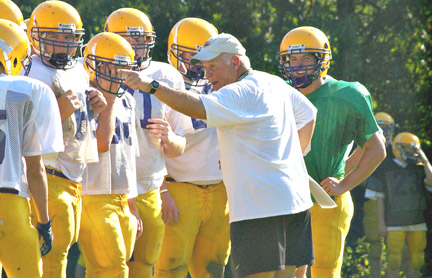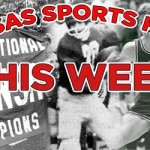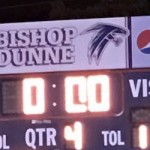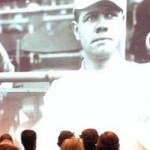Ten years ago this week – Ellis “Scooter” Register notches his 100th career win in the Arkansas high school football in his head coaching debut at Little Rock Catholic. Catholic scored on seven of its nine possessions in a 45-20 victory over North Pulaski at War Memorial Stadium.
Register spent the previous eight seasons at El Dorado. Before that, he coached five years at Little Rock McClellan. “I’m just excited for the kids and excited about being at Catholic,” Register said after the North Pulaski win. “I guess it’s great to do that [win 100 games], but we won’t spend a lot of time talking about that.” [Arkansas Democrat-Gazette; Sept. 6, 2003]
Scooter Register left Catholic High School and was named the head coach of Little Rock Central on December 22, 2009. In 2005, he led the Rockets to an 11-2 season and 7A Central Conference Championship. Overall, Register’s teams have won five conference championships and appeared in two state finals. In 2009, Scooter Register was selected by his peers to serve as head coach for the East All Star Team in the AHSCA All Star Game. This was his fourth appearance on the All Star staff having served three times as an assistant. [Courtesy Central High School]
His Central High team faces Catholic High at War Memorial for the traditional season opener Thursday, Sept. 5, 2013.
***
In recent decades, Catholic’s grip on central Arkansas private school talent has been loosened by the emergence of new private schools in the area raring to make a mark in athletics.
The newest entrant into this fray is Episcopal Collegiate School (formerly Cathedral), which won its first varsity football game 14-6 over Caddo Hills. Episcopal’s head coach is Pip Runyan, who spent the past four seasons at Greene County Tech and before that coached at Parkin, Forrest City and Mills.
Runyan’s first task is carving out an identity for his squad. He’ll do that by employing an offensive attack heavy on the triple option he used at Greene County Tech.
Updating uniforms will also help. Since Episcopal changed the name of its school in July, its players beat Caddo Hills while still wearing jerseys with “Cathedral” stripped across the front. [Arkansas Democrat-Gazette; Sept 5 and 6; 2003]
Albert Pujols is only 23 years old but he’s already made a significant mark on St. Louis Cardinals history.
The powerful left fielder/first baseman is leading the National League with a .365 average. Pujols is tied for second with 39 home runs, second with 118 RBI and first with 124 runs, which gives him a shot to be the first player to win the Triple Crown since Carl Yastrzemski in 1967. These numbers reflect the consistency he’s shown so far in his career: Pujols is the only player in major league history who will hit at least .300 with 30 home runs, 100 RBI and 100 runs scored in his first three seasons.
***
Throw in a 30-game hitting streak earlier this summer – the longest by a Cardinals player since Stan Musial’s 30-game streak in 1950 – and it becomes difficult to imagine what this guy’s ceiling is.
Broadcaster Mike Shannon, who’s called Cardinal games for 32 years, says: “This is a dream. This is storybook stuff. This is Dizzy Dean and A Painted House,” he said, referring to John Grisham’s book about growing up in northeast Arkansas and listening to Cardinals games. “It’s the Gashouse Gang. And it’s Musial and everything rolled into one. This guy will take you back and send you forward. You’re riding on that big cloud. We’re watching a movie. Cecil B. DeMille production.”
It’s been quite an ascent for Pujols since St. Louis drafted him in the 13th round of the 1999 draft out of Maple Woods (Mo.) Community College. [the area scout who found him ended up shelving cans at a Hot Springs Wal-Mart]
Cardinals Manager Tony La Russa says Pujols’ preternatural hitting ability helps make him the best player he’s ever managed. And although Pujols has done so much already, keeping it up will be another matter altogether.
“Will he keep doing it for the next 12 to 15 years?” La Russa asks. “That’ll be the test.” [Rocky Mountain News; Sept. 8, 2003]
25 years ago …
Fort Smith reigns in prep football. After the first week of games, Southside remains No. 1 after beating Pine Bluff 17-10. Northside stays at No. 2 after tying Missouri powerhouse Rockhurst 29-29.
Here’s the entire AP top 10:
1. FS Southside
2. FS Northside
3. Jacksonville
4. Arkadelphia
5. LR Central
6. LR Catholic
7. Hot Springs
8. Springdale
9. Forrest City
10. Pine Bluff
Others receiving votes: Fayetteville, LR Mills and Rivercrest
[Associated Press; Sept 6, 1988]
100 years ago…
A Baseball Mystery
In the early 20th century, barnstorming baseball teams of so-called “bloomer girls” – composed of mostly women along with a few men – roamed the nation, seeking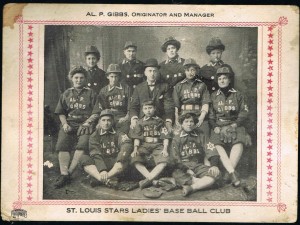 pay days by playing any male teams willing to risk losing to a bunch of women.
pay days by playing any male teams willing to risk losing to a bunch of women.
It was big business that attracted massive crowds. Some of the men on these teams cross-dressed. And some of best females became brands all to themselves. Take a virtuoso hurler named May St. Leon. In first years of the century, she toured the nation as a performer in the Ringling Bros. circus. By the start of World War I, she was manager/player of her own baseball team.
But in between those stints, St. Leon – considered the greatest female pitcher of the era – headlined a group of bloomer girls managed by businessman Al P. Gibbs.
And in early September, 1913, Gibbs’ ladies team found themselves booked for an exhibition game appearance at Little Rock’s West End Park. They were scheduled to play during a weekend “All-Star” events extravaganza featuring a matchup between the best city league players around.
St. Leon’s team featured all women except for men at shortstop, catcher and one fielder position. Who, exactly, their opponents were presents to us a bit of a mystery.
***

We know for sure the Hubs’ 1912 team was all-white. Courtesy: Arkansas Baseball Encyclopedia http://arkbaseball.com/tiki-index.php
We know the Gibbs’ ladies were supposed to play a group of men affiliated with the Hub Clothing company in Little Rock. We know those men were called the old “Hubs” and included white males like “Sonny” Herrick, Whitmore, Younger, Rust, Pichett and Stein (n.b. newspapers hated wasting ink on first names back then).
What we don’t know is why the following was penned by an Arkansas Democrat sports columnist on September 11, 1913:
“The Hub ‘niggers’ are being groomed for their game with the women Saturday. It will be a merry contest and it is hoped that the boys will be able to hold their own.”
Yes, this language is insulting and racist to modern readers.
But, at first glance, it seems to make little sense in the context of those times.
If we take the word literally, then we are to believe that some African-American males had joined the team. A mixing of black and white players in this era, in the South, is rare but not unheard of. Although, when it happened, it was typically an all-black team playing against an all-white team.
Either way, only males were involved. What would be extremely rare (if not outright unprecedented) would be an early 20th century instance of black males competing against white women.
I checked with Guy Lancaster, editor of The Arkansas Encyclopedia of History and Culture, on the matter. He wrote back: “While sometimes Negro League men’s teams did play white men’s teams, I’ve never heard of any game from the period that crossed both racial and gender lines.”
Lancaster’s best guess, as is mine, is that the parentheses around the word mean it’s being used as a metaphor. These Hubs were all white, it seems, but they might have been affiliated with something involving blackness. Perhaps, the Hubs wore dark uniforms. Perhaps, the sports columnist is using the word in a good-natured way – a way that’s commonly used within the African-American community itself these days but otherwise is no longer socially acceptable.
Lancaster wrote: “It could indeed be used as a term of familiarity, if not endearment. It was not uncommon for whites to refer to known African Americans as “Nigger Tom” or “Nigger George” without the negative connotation that word definitely carries today. One often finds African Americans known to the wider community referred to in such a manner even in newspapers of the era.”
He adds: “Of course, this isn’t to say that the word was completely without opprobrium or that whites used it innocently.”
Another disturbing possibility is brought up by Bryan McDade of the Mosaic Templars Cultural Center in Little Rock: “I wonder if it could have been some sort of comic exhibition game? The term may have been used to describe a comic, foolish behavior that was associated with an African American stereotype rather than actual African Americans. Maybe the white players may have put on ‘black face.’ ‘Black Face’ vaudeville acts were pretty popular around this time.”
[Arkansas Democrat; Sept 11 and 12, 1913]
I plan to one day look at more newspapers accounts from the period, but until then…
What’s your best guess regarding this mystery?
Was the Democrat columnist’s line just a throw away with no deeper meaning, or could it be the first step in uncovering a forgotten corner of baseball history?
***
Follow Demirel on Twitter. He also blogs about local sports and society.


